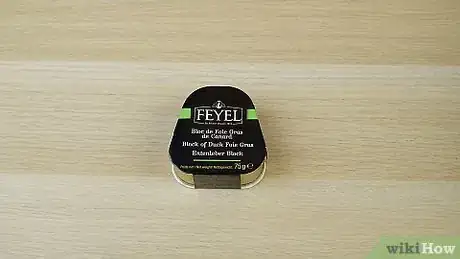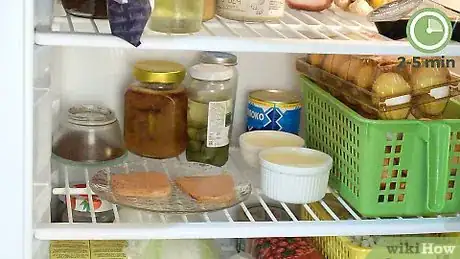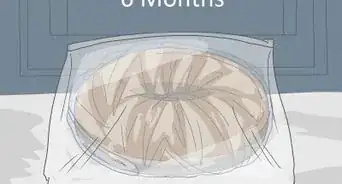This article was co-authored by wikiHow Staff. Our trained team of editors and researchers validate articles for accuracy and comprehensiveness. wikiHow's Content Management Team carefully monitors the work from our editorial staff to ensure that each article is backed by trusted research and meets our high quality standards.
There are 8 references cited in this article, which can be found at the bottom of the page.
The wikiHow Video Team also followed the article's instructions and verified that they work.
This article has been viewed 125,457 times.
Learn more...
Foie gras is French for “fatty liver” and normally refers to the liver of a duck or goose. Serving this dish for the first time can seem intimidating, but the process is actually quite simple. All you need to do is bring the foie gras to the right temperature and trim it into small slices. Foie gras can be eaten as is in order to experience its full, rich flavor. It can also be paired with a number of sweet or tart accompaniments to make your meal even more colorful.
Ingredients
- Pre-cooked foie gras
- Lightly toasted bread (optional)
- Dried fruit, fruit preserves, or fruit sauce (optional)
- Dessert wine (optional)
Steps
Heating Raw Foie Gras
-
1Choose pre-cooked foie gras to avoid cooking. Pre-cooked foie gras is often sold in cans or tins. Look for the word “cuit,” which is French for cooked. You may also see “mi-cuit” liver, which has been partially cooked through slow poaching. This type of foie gras is also ready to eat right away, having a softer flavor due to the longer cooking time.[1]
- Mi-cuit foie gras can be stored for about 3 months. Cuit foie gras can last for years on your shelf.
- Raw foie gras is “cru.” Since it is fresh, it only lasts a few days in your refrigerator. It is served warm.
-
2Heat a pan over medium heat on the stove. You do not need to add butter or cooking oil to the pan. Simply turn on the heat and let the pan warm up for about 5 minutes. Get the pan as hot as possible so it sears the liver right away. To test this, place a few drops a water in the pan. If they evaporate right away, your pan should be ready to go.[2]
- Foie gras, especially the duck variety, is very fatty. The fat in butter and oil can make the taste even richer than usual.
- If you wish to try using oil, pour about 1 tsp (4.9 mL) of olive or canola oil into the pan before heating it.
Advertisement -
3Cook the foie gras for about 30 seconds on both sides. Due to the high fat content, foie gras cooks quickly. Set it in the pan and don’t move it. After 30 seconds elapse, lift the liver with a spatula. If it is finished, it will have a deep, brown color. Flip it over and cook the other side the same way.[3]
- If you have a big piece of foie gras, try slicing it first so it cooks completely.
- Cleaning raw foie gras isn’t essential. Foie gras has a lot of stringy nerves, but they melt during the cooking process. If you want to make sure they are gone, pull them off by hand before slicing.
- Leaving the foie gras in the pan for too long causes it to shrink and look greasy.
-
4Rest the foie gras on a paper towel for 1 minute. Set a paper towel over a plate on your counter. Let any dripping fat and juice run off. After about a minute, the liver’s center should feel soft. You can then enjoy it with bread or another accompaniment.[4]
Slicing and Plating Foie Gras
-
1Chill foie gras in the refrigerator before serving it. Cold temperatures help preserve the foie gras’ shape. Remove it from its packaging, then set it in a covered glass or porcelain dish. You should put the foie gras in the refrigerator for between 2 to 5 minutes to chill it slightly, unless you are eating a paté. This will prevent the foie gras from crumbling when you cut it.[5]
- For paté, leave the liver in its container or in a covered dish on your counter until it reaches room temperature.
- Most people find the taste from hot foie gras to be overwhelming, so chilling it can improve its flavor. If it gets too cold, though, you may lose some of its taste and texture.
-
2Warm a non-serrated knife under running water. Due to its high fat content, foie gras can fall apart when you cut it. Serrated blades will tear the meat, so choose a smooth blade. Turn the hot water tap on in your sink to keep the blade heated and clean as you cut the meat.
- You should warm and clean the blade after each slice you make. Use a towel to wipe the blade dry each time.
-
3Slice the foie gras into 1⁄2 in (1.3 cm) chunks. Foie gras is normally eaten in sizable chunks. You can cut the slices bigger than this if you wish. Smaller slices usually leave you wanting more since you don't get an adequate taste of the liver's complex flavor.[6]
- For the best results, cut the foie gras when it is chilled or at room temperature.
- The average serving is 1.7 to 2.5 oz (48 to 71 g) when served as a starter or 3.5 to 5.3 oz (99 to 150 g) when prepared as a main course.[7]
- Note that only “torchon” foie gras, which comes in the shape of a log or loaf, needs to be cut. “Terrine” foie gras comes pre-cooked in a terrine mold and should be served directly in the terrine.
-
4Plate the foie gras after slicing it. Unless you bought a can of paté, you don’t need to smash the foie gras with a knife. Simply pick up the slices and place them on your desired serving method, such as a plate or piece of bread. Eat the liver as is or serve it with accompaniments that compliment its flavor.[8]
- Foie gras paté is soft and mushy, so you will need to use a butter knife to spread it like you would with butter, hummus or similar toppings.
- For instance, you can set the foie gras on a plate with apples, onion jam, or another component. Alternatively, lay the foie gras on top of a piece of bread.
- Enjoy the foie gras by biting into it or breaking off pieces with a fork or spoon. Whether you serve it with accompaniments or not, let it melt in your mouth.
Creating Accompaniments for Foie Gras
-
1Serve the foie gras as an appetizer to enjoy its full taste. Depending on when you choose to serve the liver, the way you serve it can change. It is commonly served on its own or as a plain appetizer. This is because the taste of foie gras can get lost when it is buried behind other foods. Serve it early in a meal so you can enjoy the dense flavor more completely.[9]
- Foie gras can be easily served plain on a piece of bread as an appetizer. You may want to add fruits and sauces if you incorporate it into a meal.
- If you serve both goose and duck foie gras, start with the goose. The fuller flavor of the duck liver can overpower the creamy, delicate taste of the goose liver.
-
2Serve foie gras with bread to make it a simple snack. A plain piece of brown or white bread is the best option. You don’t need a fancy bread with different grains or exotic spices, but a slight amount of sweetness such as from honey won’t overwhelm the foie gras. Cut off a slice of bread about the same size as a slice of foie gray. Lay the foie gras on top of the bread and enjoy it with your hands.[10]
- Country-style bread is commonly used with foie gras, but sourdough bread has become a popular choice as well.
- You can also pair foie gras with brioche or fruit bread. Sweet fruits, such as figs and apricots, compliment the rich flavor of the liver.
- Consider lightly toasting your bread to use as a warm, solid support for the foie gras.
-
3Pair the foie gras with acidic fruits for additional flavor. Various fruits, including green apples, strawberries, and cherries, can be served in slices along with the foie gras. Try spreading fruit preserves over a piece of bread or pouring a fruit sauce over foie gras on a plate. Tart and acidic fruits cut through the sweet, rich taste of foie gras, creating a balanced dish that hits a range of flavors.[11]
- Sweet and sour items are among the best options. Try a cranberry jelly, citrus sauce, or an Asian-inspired chutney.
- Dried fruit like figs and prunes work well with foie gras. Stone fruits such as peaches, plums, nectarines, and sour cherries also work.[12]
- Another option is to make an acidic sauce such as an onion jam or green apple sauce mixed with balsamic vinegar. Also consider liquor-based sauces such as caramel mixed with cognac or sherry.
-
4Use a light amount of dressing if you include a salad. Salads make for light side dishes when paired with foie gras, but you have to be careful about how much dressing you use. Put the salad in a mixing bowl, then pour a sparing amount of the dressing on top of it. Mix the salad until it is lightly coated, adding more as needed, then add the foie gras slices on top of it.[13]
- A balsamic vinaigrette dressing is a great choice since it has a sweet, tart taste that contrasts well with the liver. However, you can use other dressings if you prefer.
- You can make your own dressing by mixing 1 US tbsp (15 mL) of balsamic vinegar with 2 US tbsp (30 mL) of olive oil. Be careful not to use too much oil, since the fat in it can make the fatty liver difficult to stomach.
-
5Accompany foie gras with a sweet wine. Wine is another way to mix sweet flavors with the rich, heavy taste of the liver. Like a good French dish, foie gras goes well with a glass of a Sauternes. Also try a sweet wines from the Alsace or Loire Valley regions in France. German Rieslings are another sweet choice that can bring the most out of your foie gras.[14]
- You aren’t limited to only those wines. Additional options include Jurançon, Monbazillac, Bergerac, and Gewurztraminer. You may even wish to try the liver alongside a port wine.
- Champagne has not traditionally been paired with foie gras, but it has become a popular option. Use a dry champagne to avoid overwhelming your taste buds with too much sweetness.
- Ask your guests for opinions. Some people may say that wine distracts from the taste of foie gras and forego it.
Community Q&A
-
QuestionWhich fruit bread can I serve with foie gras?
 Hélène FuchsCommunity AnswerAnything with dried figs, dried apricots, and/or prunes is always considered a safe bet. Any dried fruit that tastes very rich and sweet with just a hint of acidity will work well with foie gras.
Hélène FuchsCommunity AnswerAnything with dried figs, dried apricots, and/or prunes is always considered a safe bet. Any dried fruit that tastes very rich and sweet with just a hint of acidity will work well with foie gras.
Things You'll Need
- Sharp non-serrated cutting knife
- Plates
- Fork or spoon
- Refrigerator
References
- ↑ https://parisbymouth.com/primer-foie-gras-in-its-many-forms/
- ↑ https://www.seriouseats.com/2012/12/food-lab-pan-seared-foie-gras-how-to.html
- ↑ https://www.epicurious.com/recipes/food/views/sauteed-duck-foie-gras-105578
- ↑ https://www.epicurious.com/recipes/food/views/sauteed-duck-foie-gras-105578
- ↑ https://everydayfrenchchef.com/recipes/starters/foie-gras/
- ↑ https://www.seriouseats.com/2012/12/food-lab-pan-seared-foie-gras-how-to.html
- ↑ http://www.cordonbleu.edu/news/servefoiegras/en
- ↑ https://www.seriouseats.com/2012/12/food-lab-pan-seared-foie-gras-how-to.html
- ↑ https://www.cordonbleu.edu/news/servefoiegras/en
- ↑ http://thefoiegras.co.uk/our-tips/what-to-eat-with-foie-gras
- ↑ https://www.seriouseats.com/2012/12/food-lab-pan-seared-foie-gras-how-to.html
- ↑ http://www.seriouseats.com/2012/12/food-lab-pan-seared-foie-gras-how-to.html
- ↑ https://everydayfrenchchef.com/recipes/starters/foie-gras/
- ↑ https://parisbymouth.com/primer-foie-gras-in-its-many-forms/
About This Article
Foie gras is a small dish usually made of duck or goose liver. If your foie gras isn’t precooked, fry it in a pan on medium heat for 30 seconds on each side or until it’s a deep brown color. Don’t use oil or butter, since the foie gras is fatty enough by itself. Keep the foie gras in the fridge until you serve it to preserve its shape. Then, slice it into half-inch chunks and serve it on country-style bread or sourdough bread as an appetizer. You can also serve it with acidic fruits, like green apples, strawberries, or cherries, to offset its rich, full flavour. Like any good French dish, foie gras also goes well with a sweet wine, like Sauternes. For more tips, including how to serve foie gras in a salad, read on!























































